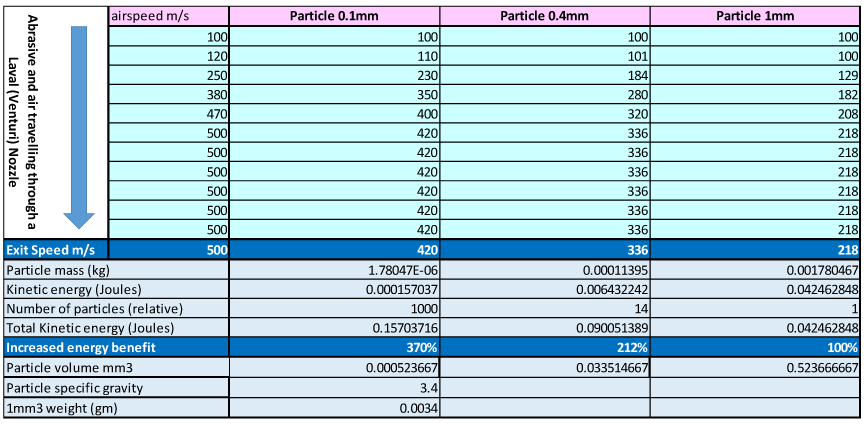Techinical Tips
DUST FACTOR: Low
RECYCLABILITY: 5+
GRADES AVAILABLE: EB70 and EB90
CONSUMPTION RATE: 7 – 15kg per M2
PROFILE RANGE EB70: 50-80 microns
PROFILE RANGE EB90: 60-95microns

ABRASIVE FLOW RATE
Amongst the many variables affecting abrasive blasting efficiency and cost, little attention has been paid to the effect of abrasive feed rate on operations.
To re-cap, the following variables all affect blasting efficiency and cost:
- Air pressure
- Nozzle design and size – matched to air
- pressure and job at hand
- Abrasive – matched to air pressure and job requirement
- Operator skill
- Coating and contaminants to be removed
- Site management including performance measurement
- ABRASIVE FLOW RATE
During the development phase of ecoblast®, over forty test blasts were carried comparing expendable abrasives including platinum, copper and coal slag, garnet, crushed glass, ilmenite and some combinations of both. Test results included coarse (+2mm) to ultra-fine (<180 micron) abrasives under conditions ranging from blasting off 3mm thick glass flake to “C” grade new steel and with air pressures ranging from 5.5 to 6.5 bars. Performance results varied dramatically, as expected. Data was tabled for each test under the following headings:
- Abrasive flow rate/hour
- M² cleaned per hour
- M² cleaned per ton
Statistical analysis showed a correlation between the flow rate of the abrasive to both the cleaning rate (Square metres per hour) and the cleaning performance (Square metres per ton). Blasting performance increased up to a point with increased abrasive flow and then dropped off significantly.
The analogy to these results is that if you drive from A to B at 160 KPH, you will use more fuel than at a sedentary 90 KPH. Fuel consumption increases exponentially. The same is true of abrasive consumption.
The results from the test data
so far (an ongoing project) is depicted graphically below.
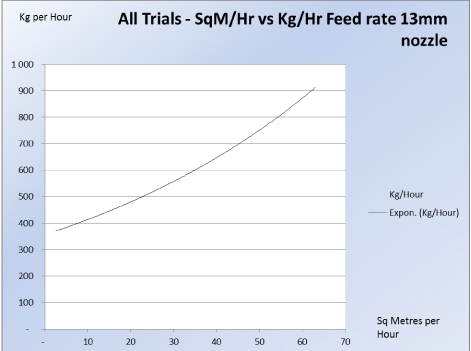


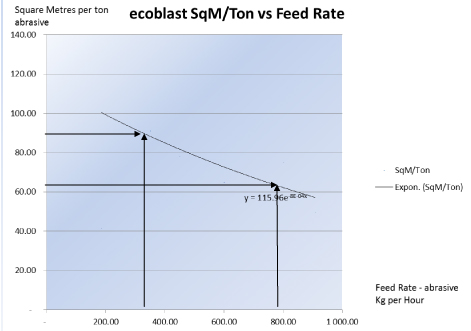
It should be mentioned that overfeeding abrasive into the mixture reaches a point where no improved performance will result. There is an optimum point, just like fine tuning a car engine. Using this data, contractors will have better control over costs and by regulating abrasive feed rates, will be able to optimize speed versus abrasive economy according to individual requirements.
As a rule of thumb, an efficient air/abrasive mixture will only be slightly visible, appearing as a coloured haze in the airstream. If you see a lot of colour in this flow, there is too much abrasive (and not enough air) in the mixture. Why? Your abrasive metering valve is open too far. When this happens, cleaning efficiency is not at its optimum and valuable abrasive is being wasted.
Create the best mixture by starting off with no abrasive and slowly open the metering valve until you can just see the colour change in the airstream. That’s all the abrasive you need for fast, efficient blasting.
METERING VALVES
Good quality metering valves are essential to get optimum abrasive flow rates.


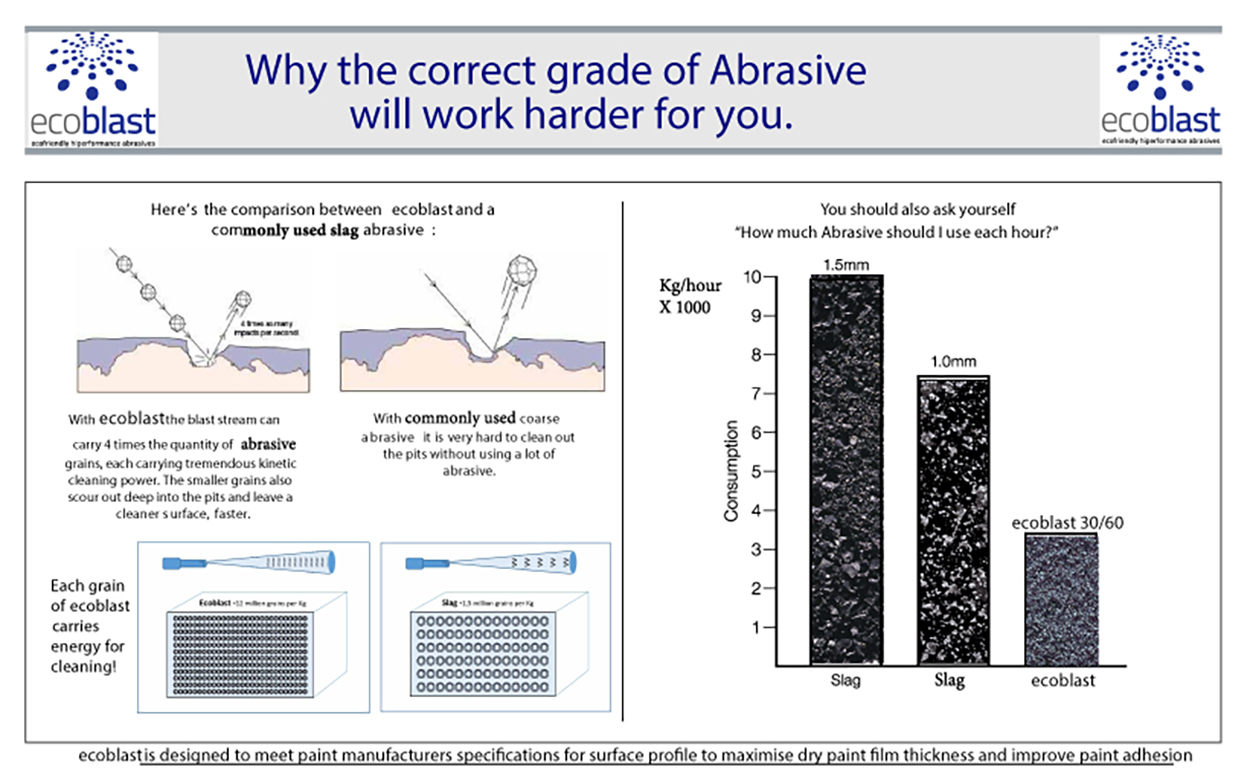
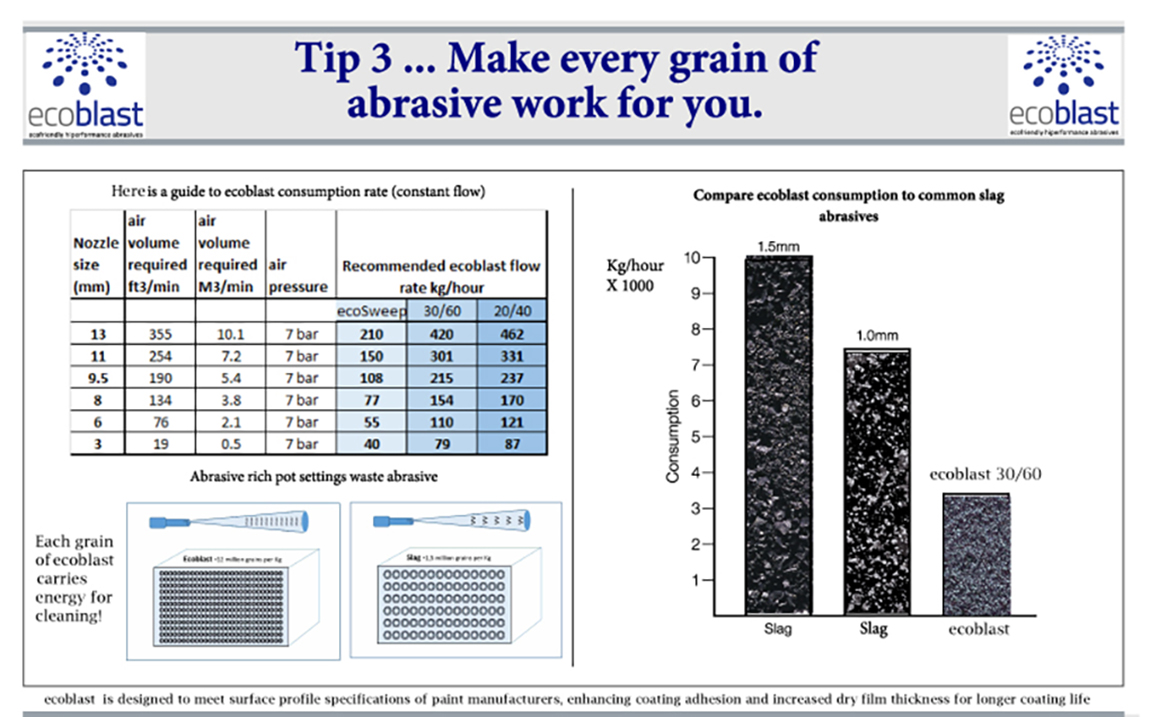
Why do “finely” graded abrasives improve productivity and save costs?
“More bullets per kilogram” is the catch phrase ecoblast®, a national supplier of abrasive blast media, uses to explain to their customers why their standard 30/60 (0.2 – 0.6mm) graded abrasive blast media is so efficient. This article explains why fine abrasives impart more energy than coarser products to surfaces being pneumatically grit blasted and can drastically reduce the cost of high quality surface preparation. Alluvial garnet took the abrasive market by storm in the 1980’s. Sure, it’s a great abrasive and its pretty pink colour makes it even more aesthetically pleasing. But its true value lies in the fact that it is a finely graded blast medium mined from alluvial deposits which have a natural particle size predominantly less than 0.6mm. Today, 30/60 garnet is world renowned as a premium blasting media and was the world leader in successfully proving the “more bullets per kilogram” philosophy. Yet there is still a mental block amongst some contractors in spite of all the practical evidence, that we should be abrasive blasting with “coarse” (>1mm) abrasives to achieve cost effective performance!
Why?
To understand how “fine” abrasives transfer more energy to the surface being blasted and are therefore more
efficient, we need to look at two simple but important factors:
2. What is the equivalent energy imparted on the blast surface from fine particles versus the coarser
particles?
Number of Particles (bullets) per kilogram

Energy (cleaning ability) of an abrasive particle
The energy (cleaning ability) of an abrasive particle to do its job is dependent and measured by its kinetic energy. Kinetic energy is measured in “Joules” (named after the English physicist James Prescott Joule). The formula to calculate kinetic energy is KE = ½mv² where m = mass (in kilograms) and v = velocity (in metres per second). Clearly from this equation, the velocity (v²) of the abrasive particle plays an increasingly more important role than its weight (m)! The abrasive blasting industry has indeed recognised the added efficiency of particle velocity and it is an industry standard to use a Laval (venturi) nozzle, based on rocket technology and which accelerates air and abrasives in the airstream up to around 500m/second. However, abrasive particles have inertia. Inertia is the resistance of the abrasive particle to change its speed and the bigger the mass (size) of the particle, the greater will be its resistance to change its speed. This phenomenon is depicted in the graph below which shows that smaller abrasive particles accelerate and exit the blast nozzle at a higher velocity than larger abrasive particles.
Using the above research, it becomes much easier to understand why finer abrasives are more efficient. If we simply calculate the energy transmission of fine abrasives versus coarser abrasives, we can see why!
We can see from the calculations that the impact energy of 1 X 1mm particle is about 6 times higher (0.042J) than a single 0.4mm particle (0.0064J). But if we take the collective energy of the same mass of 14 X 0.4mm particles, we can see that the smaller particles deliver 2.1 times the energy due to their higher velocity and concomitant energy. Translate the theory into practice and blasting costs could be more than halved!

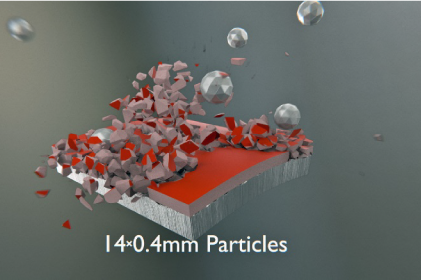
The answer lies in the fact that we still need to create a surface profile that is acceptable for most industrial coatings of say 50-100 microns. Ecoblast® has worked out that this can be achieved, along with international garnet suppliers with a grade of 30/60 which delivers the best of both worlds – high productivity and acceptable surface profile. Demands on the industry dictate that we should look at every avenue to save costs. This one is obvious.


